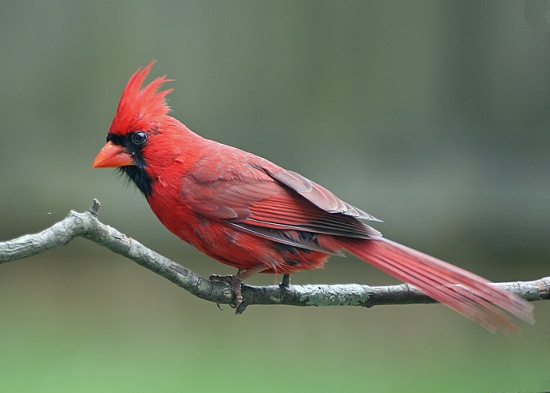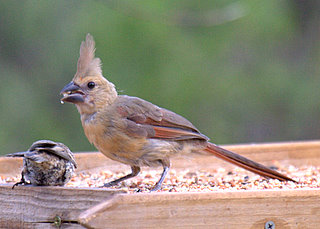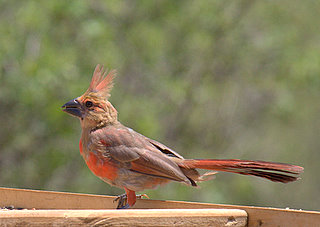m (enlarge small photos) |
(Referenced for copied text) |
||
| Line 35: | Line 35: | ||
*''C. c. saturatus'': Cozumel Island (off Quintana Roo) | *''C. c. saturatus'': Cozumel Island (off Quintana Roo) | ||
==Habitat== | ==Habitat== | ||
| − | Typical habitats are thickets and brushy areas, edges and clearings, riparian woodlands, parks, and residential areas. | + | Typical habitats are thickets and brushy areas, edges and clearings, riparian woodlands, parks, and residential areas.<sup>[[#References|[2]]]</sup> |
==Behaviour== | ==Behaviour== | ||
| − | Winter flocks can be very large, up to 60 or 70 individuals in areas of abundance. | + | Winter flocks can be very large, up to 60 or 70 individuals in areas of abundance.<sup>[[#References|[2]]]</sup> |
====Diet==== | ====Diet==== | ||
| − | Cardinals feed on a variety of foods including seeds, leaf buds, flowers, berries, and fruit. Up to one-third of its summer diet can be insects. Its winter diet is 90 percent vegetable matter, especially large seeds. | + | Cardinals feed on a variety of foods including seeds, leaf buds, flowers, berries, and fruit. Up to one-third of its summer diet can be insects. Its winter diet is 90 percent vegetable matter, especially large seeds. <sup>[[#References|[2]]]</sup> |
====Vocalisation==== | ====Vocalisation==== | ||
| − | Cardinals are noted for their loud, clear whistled songs, often sung from a high treetop song post. Females will counter sing, duetting with males—usually after the males have established territories and before nesting begins. Local variations and accents have been noted in cardinal songs. | + | Cardinals are noted for their loud, clear whistled songs, often sung from a high treetop song post. Females will counter sing, duetting with males—usually after the males have established territories and before nesting begins. Local variations and accents have been noted in cardinal songs.<sup>[[#References|[2]]]</sup> |
==References== | ==References== | ||
| − | #{{Ref-Clements6thDec08}} | + | #{{Ref-Clements6thDec08}}#http://www.birds.cornell.edu/BOW/norcar/ |
{{ref}} | {{ref}} | ||
==External Links== | ==External Links== | ||
{{GSearch|Cardinalis+cardinalis}} | {{GSearch|Cardinalis+cardinalis}} | ||
[[Category:Birds]] [[Category:Cardinalis]] | [[Category:Birds]] [[Category:Cardinalis]] | ||
Revision as of 11:37, 12 March 2010
- Cardinalis cardinalis
Identification
Length: 7.75 inches
All ages and sexes have a crest and large, conical bill
Male
All red with black mask and chin. Wings have some gray. Red bill
Female
Brown overall with some red in wings, face, and tail. Red bill
Juvenile
Similar to female but bill is dark instead of red.
Distribution
United States and Mexico.
Taxonomy
Subspecies[1]
- C. c. superbus: Extremese California to Arizona, south-western New Mexico and northern Sonora
- C. c. seftoni: Central Baja California (south to latitude 27°N)
- C. c. igneus: Southern Baja California (north to latitude 27°N)
- C. c. clintoni: Isla Cerralvo (Gulf of California)
- C. c. townsendi: Isla Tiburón (Sea of Cortés) and adjacent coastal Sonora
- C. c. affinis: Western Mexico (south-eastern Sonora to south-western Chihuahua and western Durango)
- C. c. sinaloensis: Coastal western Mexico (Sinaloa and Jalisco)
- C. c. mariae: Tres Marías Islands (off western Mexico)
- C. c. carneus: Coastal western Mexico (Colima to Isthmus of Tehuántepec)
- C. c. cardinalis: Eastern US
- C. c. floridanus: South-eastern Georgia and peninsula Florida
- C. c. magnirostris: South-eastern Texas and southern Louisiana
- C. c. canicaudus: Western Oklahoma and western Texas to east-central Mexico
- C. c. coccineus: Eastern Mexico (eastern San Luis Potosí, Veracruz, north-eastern Puebla and n Oaxaca)
- C. c. littoralis: Lowlands of eastern Mexico (southern Veracruz and Tabasco)
- C. c. yucatanicus: South-eastern Mexico (Yucatán Peninsula)
- C. c. flammiger: South-eastern Mexico (southern Quintana Roo), Belize and Petén of northern Guatemala
- C. c. saturatus: Cozumel Island (off Quintana Roo)
Habitat
Typical habitats are thickets and brushy areas, edges and clearings, riparian woodlands, parks, and residential areas.[2]
Behaviour
Winter flocks can be very large, up to 60 or 70 individuals in areas of abundance.[2]
Diet
Cardinals feed on a variety of foods including seeds, leaf buds, flowers, berries, and fruit. Up to one-third of its summer diet can be insects. Its winter diet is 90 percent vegetable matter, especially large seeds. [2]
Vocalisation
Cardinals are noted for their loud, clear whistled songs, often sung from a high treetop song post. Females will counter sing, duetting with males—usually after the males have established territories and before nesting begins. Local variations and accents have been noted in cardinal songs.[2]
References
- Clements, JF. 2008. The Clements Checklist of Birds of the World. 6th ed., with updates to December 2008. Ithaca: Cornell Univ. Press. ISBN 978-0801445019.
- http://www.birds.cornell.edu/BOW/norcar/
Recommended Citation
- BirdForum Opus contributors. (2024) Northern Cardinal. In: BirdForum, the forum for wild birds and birding. Retrieved 19 April 2024 from https://www.birdforum.net/opus/Northern_Cardinal






